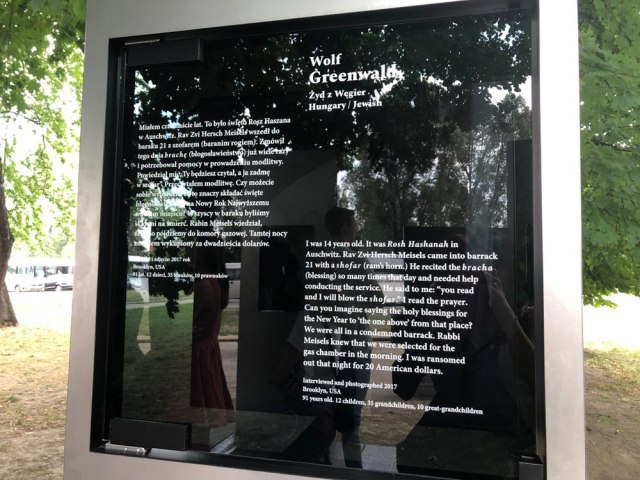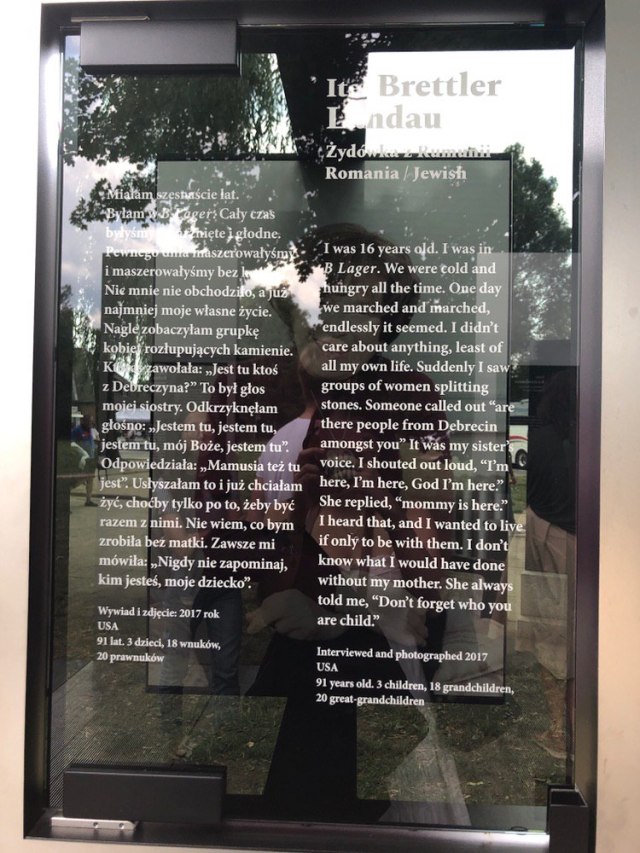Have been procrastinating on writing about the fourth day of our trip because we visited Auschwitz that day and it’s such a depressing topic to revisit :/ Nevertheless, I think I better get round to it before I completely forget my thoughts on the subject.
Café Camelot
That morning, M and I had brunch at Café Camelot, a cute, convivial Israeli café described by Washington Post writer, David Streitfeld, as his “favourite café in the world”.

I ordered shashouka in keeping with the Israeli theme and M had carbonara penne. The food was excellent. I’ve only had shashouka once at Wild Honey, which Café Camelot beat hands down. And I’m usually finicky about pasta (must be al dente, handmade, etc), but M’s carbonara exceeded my expectations! Firm, flavourful, and with a burst of umami.

Auschwitz-Birkenau II
After brunch, we caught our bus to Oświęcim where the infamous Auschwitz-Birkenau II concentration camp is located.
Actually, Auschwitz was the main reason we chose to visit Europe this August. Being a big World War II buff, M had always wanted to visit Auschwitz but missed it a few years back because he missed his plane to Krakow. On my part, the former concentration camp had been on my radar while I was on exchange in Europe, but I never really got around to it because there were always less depressing places to visit. I mean, the historical richness of a city has always been and will always be a top priority for me in picking a travel destination, and I did love my visit to the Anne Frank House in Amsterdam (loved The Diary of Anne Frank growing up). But I think it is not difficult to see why I’d be worried about how depressing a visit to a site of mass murder would be.
That said, I’m glad we had that experience though I don’t think I’ll be revisiting anytime soon.
Initially, we contemplated booking a tour with a travel agent, but most reviews suggested that such tours tend to be incredibly rushed. M really wanted to be able to walk around on our own and take the time to fully process the events that transpired there, so we ended up booking a round bus trip on our own, and joining an on-site tour on arrival. As I understand it, it is not possible to enter the campgrounds without joining an on-site tour but doing it our way would give us about two hours post-tour to see the place at our own pace.
The tour was sectioned into 2 parts: an 1.5 hour-long visit to Auschwitz I (the main camp), followed by a short break before we caught the bus to Auschwitz II-Birkenau (the second camp built to ease congestion in the first and site of the first gas chambers) 3km away.

At Auschwitz I, we saw a gallery featuring photos of former inmates with their date of internment and date of death. All, including the women, had had their heads shaved bald and their identification numbers tattooed. Based on the dates featured, most lasted a mere 2-3 months before succumbing to torture and/or the horrendous living conditions at the camp. I don’t think I would have lasted a day.
We also visited the infamous gallery of personal artefacts robbed from the camp inmates: mountains of shoes in every shape and size, piles of misshapen horn-rimmed glasses, and cloth made of actual human hair of the victims. It was extremely disconcerting to think that each one once belonged to a living, breathing man, woman, or child slaughtered at this very site.
Out of respect of the victims, I will not post such photos here.
The gate bearing the infamous “ARBEIT MACHT FREI SLOGAN” that has become synonymous with Auschwitz. According to a book M read, the ‘B’ in ‘ARBEIT’ was inverted in silent protest.
Barb wire fences preventing escapes

The barracks where thousands were squashed
 At Birkenau, we saw the notorious train tracks on which Jews from all over Europe once arrived to be slaughtered like cattle. In fact, the very train cars used to cart them into Auschwitz were cattle wagons, built for the shipment of LIVESTOCK.
At Birkenau, we saw the notorious train tracks on which Jews from all over Europe once arrived to be slaughtered like cattle. In fact, the very train cars used to cart them into Auschwitz were cattle wagons, built for the shipment of LIVESTOCK.
 These Jews had been herded out from the Ghettos and packed like sardines into windowless cattle cars like this. Many did not survive the journey.
These Jews had been herded out from the Ghettos and packed like sardines into windowless cattle cars like this. Many did not survive the journey.
I had seen the tracks in the arrival in Auschwitz scene on Schindler’s List, but it was surreal looking at them in the flesh.
Saw a couple of tourists using the tracks as a lead line for their selfies. I was flabbergasted. It boggles the mind how anyone who had just gone on 2+ hour tour on the Holocaust would have the heart to exploit such an indispensible lever of history’s most notorious genocide for a selfie?!? How does one bring oneself to smile whilst posing for a selfies at mass grave yard? Did they not understand the horrors of Auschwitz or did they simply not care?
Faith
Stupid tourists aside…
The exhibition I liked the best wasn’t actually within the camp itself. It was the display outside the entrance showcasing quotes from survivors about Auschwitz through the lens of faith.


“in memory of those who perished; in honour of those who survived”
 “Can you imagine saying the holy blessings for the New Year to ‘the one above’ from that place?”
“Can you imagine saying the holy blessings for the New Year to ‘the one above’ from that place?”

“It was my sister’s voice. I shouted out loud, ‘I’m here, I’m here, God I’m here.’ She replied, ‘mommy is here.’ I heard that, and I wanted to live, if only to be with them.”
This broke my heart.
 “I knew if she died, I would die.”
“I knew if she died, I would die.”

“God will save you, and you will tell the world what happened to us.’

“I asked someone, ‘where are the women and children?’ He pointed to a tall chimney: ‘they went out through there.’ The only way out of Auschwitz was through the chimney: today, tomorrow, or the next day. It took me a year after liberation to return to my faith.”

“Faith was the only thing I had left. I took comfort in it.”

“A man in the group saw a yingele (a Jewish boy), dead, hanging from the gallows. He screamed, ‘where are you God?’ Another man responded, ‘you know where God is? He is on the gallows with the boy. That’s where he is.’ I saw the exact same barbarity. The man could not reconcile what he saw with a compassionate God. My father taught me that fire makes things hard or it can make them melt. My emunah (faith) became stronger that day.”
I really like how they displayed a whole spectrum of reactions to the same circumstances, from utter disillusionment to the fortifying of faith.
It made me think about how the William Cummings’ quote that “there are no atheists in foxholes” which M once mentioned.
In the face of such horrors, how does one survive without clinging on to faith – faith in the deliverance of justice some day, faith that your loved ones have passed through the gas chambers into a better place, faith that through all the wanton evil, there remains a God watching over you?
In the same breath, in the face of such horrors, how DOES one cling on to faith – faith in the good of mankind, faith in a divine justification for this senseless suffering, faith in an omniscient, omnipotent, omnibenevolent God who fails to intervene?
How would one not be irredeemably disillusioned in the face of such monstrosities? Can we ever reconcile faith with such unchecked evil?
I must sound like a broken record droning on and on about faith and the existential in every other post, but these were in fact the thoughts running through my mind.
Industrialisation of murder
Another thought that struck me was how shockingly fantastical the Holocaust actually sounds. One mad man’s race to exterminate an entire race efficiently? Scientific research to invent a way to kill quicker than guns? SIX MILLION Jews murdered in the Holocaust – how does one even process 6 million different human lives?
Frankly, if it didn’t actually happen, I think I might have considered the Holocaust beyond the realm of human imagination. Even now, my mind can’t fully grasp the scale and depth of sadism and suffering inflicted.
Of course, we all know that individual sociopaths exist in all corners of the Earth. But what really horrifies me, though, is the reality that a civilised state comprised of the average man was capable of contemplating – and worse, sanctioning! – the industrialisation of murder. It is one thing, horrible enough, to kill someone in war. But at least that is comprehensible to the human mind – after all, it is hard to deny that deaths are inevitable collateral damages of war, and a world war, at that. But to learn about how the Nazis developed the gas chambers as a means for disposing of the Jews more efficaciously than mass shootings – to listen to murder being discussed in terms of EFFICIENCY – was chilling and shocking on a different scale.
I had naturally heard about the gas chambers prior to my visit to Poland but I don’t think my mind fully processed it given the separation in time and space, until I was at Auschwitz, right at the site where they were employed.
Me: I just find it so hard wrap my head around the industrialization of murder. I mean, I get that the Germans have always been obsessed about efficiency. But what sort of psychopath speaks of murdering people in terms of fucking efficiency? And somehow they managed to find so many psychopaths to literally pull the levers of murder? I mean aren’t we, as a race, social creatures? Shouldn’t there be an evolutionary aversion to hurting your fellow man wired into our DNA?
M: Yeah, it’s crazy. But I suspect it’s a lot to do with the fact that Jews were completely dehumanized through propaganda in the eyes of the average SS soldier or even German civilian back then. If you no longer see someone as human, I guess it wouldn’t be that much different from slaughtering animals.
Our discussion made me think about the Men against Fire episode in Black Mirror,
*SPOILERS*
where soldiers were neurally implanted with augmented reality devices which distorted their vision to see normal humans as roaches to be exterminated. This enabled them to overcome the biological revulsion to kill another human.
It kinda scared me a little to think about the power of psychology. Are we one dehumanisation propaganda away from turning on each other? I mean if there’s one thing we’ve learnt from history is that it will always repeat itself.



